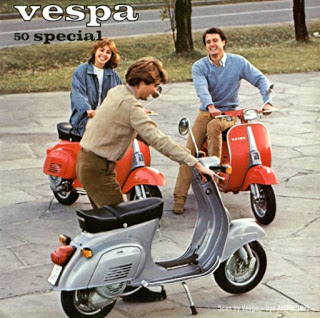
Even the most rust ravaged frame can now be brought back from the dead with a range of replacement chassis parts - such as this new floor pan
|
This page was exported from The Vespa Guide
[ http://vespaguide.com ] Export date: Thu Apr 3 6:59:27 2025 / +0000 GMT |
Vespa Small Frame Buyers Guide (Part 1) SMALL FRAME VESPA BUYER'S GUIDEPublished: 02:20PM May 20th, 2009 By: Web Editor Does all this sound familiar? If you're an avid reader of Scootering magazine it might do, because they recently ran a small frame article. But as our version is more of a buyer's guide, we deliberately held it back until they had finished theirs, both out of courtesy to them and because we thought it would make a nice follow-on.  Even the most rust ravaged frame can now be brought back from the dead with a range of replacement chassis parts - such as this new floor pan There can't be many scooterists who haven't started their two-wheeled adventures on a Vespa small frame. These mini marvels have enjoyed something of a revival of late, due to either nostalgia, the introduction of a new range of high performance kits, or just the urge to own one of the prettiest Vespas ever made. However, as with a lot of scooters which are a few years old, most small frames have had at least one careless owner who has thrashed, crashed, or hacked bits off them. What this guide will (hopefully) do is point out some of the areas to look out for as well as exploring a selection of the many models and the varied tuning and performance parts on the market, along with their availability and cost. ORIGINS By the very early 1960s Piaggio had already been producing a range of machines that fitted its design remit of a unisex vehicle for the masses. However, as the decade rolled on and the postwar population numbers boomed, Piaggio could see a market for a new model of Vespa scooter emerging from Italian society. In 1962 a law was passed where all vehicles larger than 50cc had to have a number plate. Piaggio saw this as a serious threat to its market, so a new model was designed to keep pace with both the social and legal developments. Changes in the Italian Highway Code in 1959 led to the classification of a ‘moped'. This was defined as motor cycle having ‘an internal combustion type engine not exceeding 50cc and able to travel on a horizontal road at a top speed of 45kph (28mph). Anyone over the age of fourteen could now legally ride a moped; they didn't need to have a licence, thus opening the door for a new generation of scooter riders as well as a whole sector of industry. While not being the first manufacturer to produce mopeds (or ‘micro scooters') Piaggio unveiled its design for a new 50cc Vespa to a great reception from the motor industry press in 1963. The new model featured a redesigned engine layout with the cylinder now facing at 45 degrees. This configuration would be used on all subsequent small frame Vespa scooters until the mid-1990s. The Vespa 50 weighed in at 66kg, had a three-speed gearbox with a 49.77cc cylinder with a bore and stroke of 38.4 x 43mm. This produced 1.45 bhp and a top speed of 39.5kph (24.5mph) this was increased to 2.6bhp with the later Vespa 50S. The very first Vespa 50 ran on 2.75 x 9in wheels, but these were soon replaced with the now familiar 3.00 x 10in wheels which improved stability and safety over Italy's cobbled streets. With a length of 1630mm, width of 610 mm and a dry weight of 70.5kg, the Vespa 50 was designed to be easy to use for learners. On its release it was priced at 102,000 lire (£42.23) and was an instant success with the general public. This new type of Vespa model would go on to become a sales success for the next 30 years. Part 2 - The Vespa Small Frame Models |
|
Post date: 2014-10-12 03:32:00 Post date GMT: 2014-10-12 03:32:00 Post modified date: 2014-10-12 03:32:00 Post modified date GMT: 2014-10-12 03:32:00 |
| Powered by [ Universal Post Manager ] plugin. HTML saving format developed by gVectors Team www.gVectors.com |